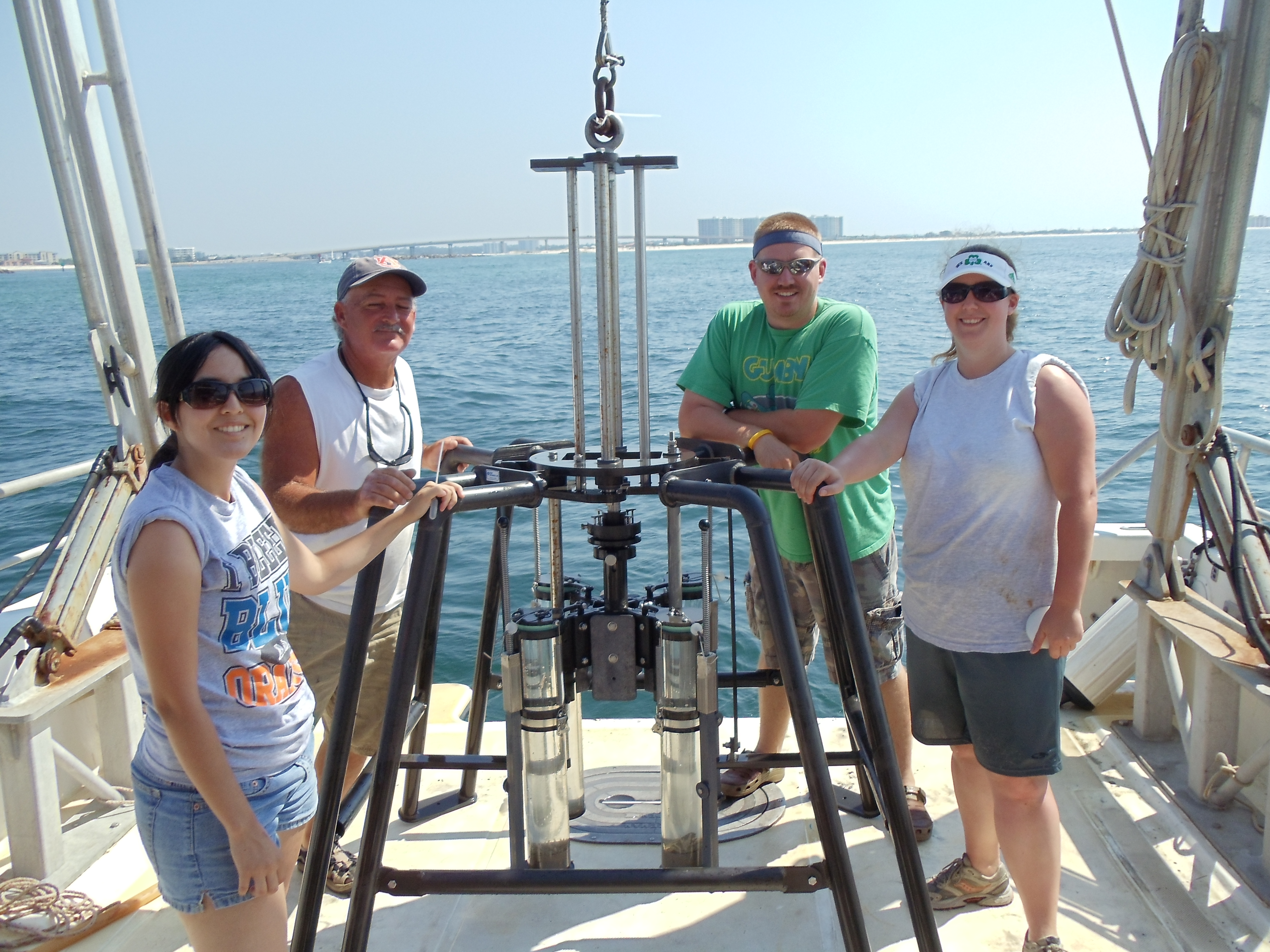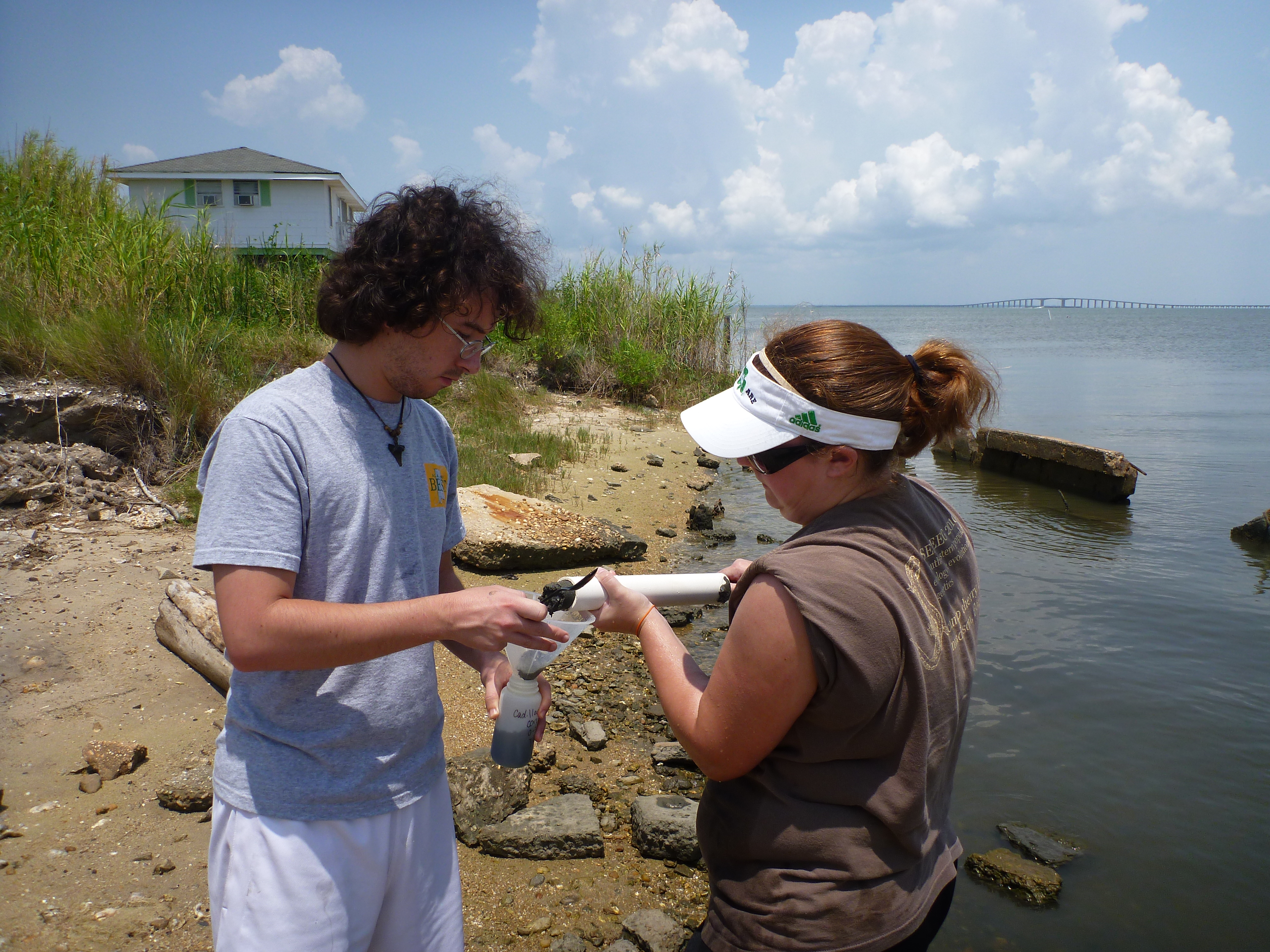COSAM News Articles 2014 December Auburn oil spill research indicates recovery for microscopic invertebrates
Auburn oil spill research indicates recovery for microscopic invertebrates
AUBURN UNIVERSITY – The results are in on Deepwater Horizon oil spill research conducted by an Auburn University postdoctoral researcher, and her study indicates microscopic animals at the base of the food web that were harmed during the 2010 oil spill have recovered.
The researcher, Pamela Brannock of the Department of Biological Sciences in Auburn’s College of Sciences and Mathematics, or COSAM, together with a team from Auburn Professor Kenneth Halanych’s lab and the University of Texas San Antonio, gathered and analyzed sediment samples taken before and after the oil reached Dauphin Island. The samples provided a basis for comparison to assess how the microscopic communities of marine invertebrates that live between the sand grains, or meiofauna, fared the oil spill.
An initial study, conducted by Halanych and colleagues at the University of New Hampshire, revealed an increased presence of fungus in meiofaunal communities. According to the study, a rise in fungus indicated organismal death, and COSAM researchers were concerned that oil, or perhaps dispersants used to clean up the spill, may have been responsible for irreversibly harming meiofaunal communities.
Brannock’s latest research results indicate the fungus that was present in large amounts in the sediment immediately after the oil spill is no longer there, which means the microscopic marine invertebrates are no longer dying at an alarming rate.
“For one year, people from the Halanych Lab intermittently collected sediment samples at five intertidal locations throughout Dauphin Island and Mobile Bay,” Brannock said. “We would freeze the sediment immediately on dry ice and then store it in the minus 80 degree freezer when we came back. Coming back into the lab we would do this process called ‘decanting,’ which is basically agitating the sediment in order to release the organisms. We would then isolate the meiofauna, or animals, on a sieve, and we would extract the DNA from that material. We would then send the DNA off to be sequenced, and we used computers and bioinformatics to determine which animals were present in the communities sampled.”
Researchers are relieved that the microscopic invertebrates seem to no longer be in danger of mass destruction. However, Brannock’s research also shows that while fungus is no longer present, there has been a significant shift in the composition of meiofaunal communities compared to pre-spill communities. The research was published in The Biological Bulletin and can be read here.
“These communities of small organisms have recovered from the oil spill, but we are still trying to assess how much natural variation exists in these communities,” Halanych said. “These communities are important because they are at the base of the food web, and they are also critically involved in helping pass nutrients and chemicals back and forth from the sediment to the water column. Pamela has continued to look quite extensively at these small organisms to see how they are faring and whether their communities are changing.”
Halanych said this kind of research is critically important to assessing the health of the Gulf Coast ecosystem.
Auburn University researchers continue to investigate effects of the oil spill
“One of the things we have learned is that the effects from an environmental catastrophe like this can take a long time to be realized,” Halanych said. “One of the main reasons we should be concerned with or interested in studying the effects is, in all likelihood, another spill is going to occur. The Gulf Coast region has a huge number of rigs, about 4,000, and we keep going into deeper and deeper water to drill. As you move into deeper water, the engineering challenges become greater and greater and greater. The concern is another big blowout, like the Deepwater Horizon, may happen in the Gulf. The hope is we have collected enough information about the Deepwater Horizon spill that we can apply that knowledge to the next spill and be able to control the damage a little bit better.”
As a member of the Gulf of Mexico Research Board, Halanych has his finger on the pulse of oil-spill-related research in the Gulf. The 20 scientists that make up the board are tasked with distributing $500 million over a 10-year period for oil spill research. The board awards funds to investigators based on a highly competitive, peer-reviewed proposal process. BP provided the funding for the Gulf of Mexico Research Board, but the funding is now independent of the multinational oil-and-gas company.
“This work continues, and it has already made a huge difference for the Gulf Coast region,” Halanych said. “Unfortunately, in many ways the Gulf Coast is the forgotten coast in terms of national funding priorities. The west coast, especially southern California, and the northeast really have major marine and oceanographic efforts, and there is a lot of money that goes there. The Gulf Coast does have institutions but typically federal funding does not flow in the same way to these areas. This research initiative is helping with that – it is helping to stimulate scientific research, and one of the things we are hoping is we will be able to build much stronger capacity so in the future we can address societal concerns and national research priorities.”
Halanych’s group will continue to investigate effects of the oil spill on the Gulf Coast. Brannock plans to continue her research into the composition of meiofaunal communities in the Gulf region and how they change over time so she can establish a baseline dataset for the next time an event like the Deepwater Horizon oil spill occurs. The Halanych Lab has also received soil samples from various NOAA cruises throughout the Gulf of Mexico taken right after the spill and a year after the spill. The lab is working to compare the meiofaunal communities in samples from sites located within or near the spill to communities present in samples from areas that were not impacted by the spill.
“As the spill was happening, a lot of people around the coast realized this was going to be a big deal, and people at Auburn, including researchers in the College of Sciences and Mathematics, started mobilizing because we knew there were going to be things that needed to be studied,” said Halanych. “COSAM researchers have stayed involved because we want to know the effects through time. We want to know how this will be a lasting problem or if this will be a lasting problem, and we want to be ready for the next oil spill.”
Latest Headlines
-
02/12/2025
-
02/11/2025
-
02/10/2025
-
01/30/2025
-
12/03/2024


